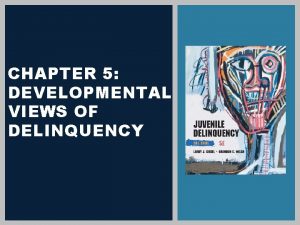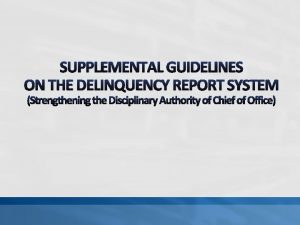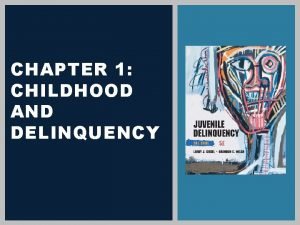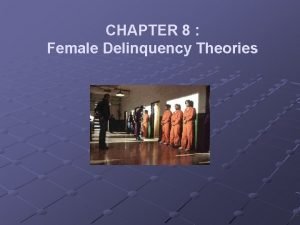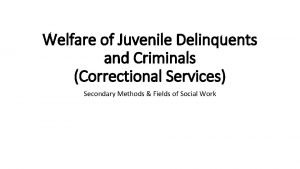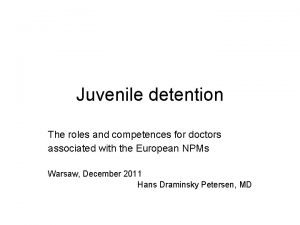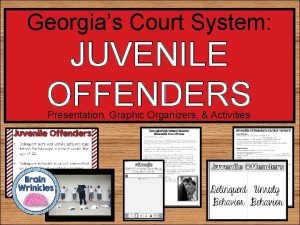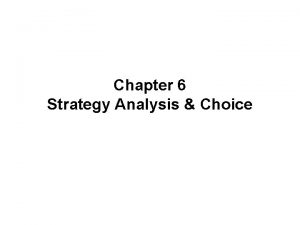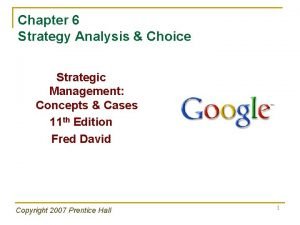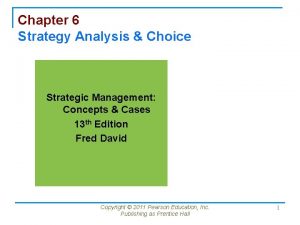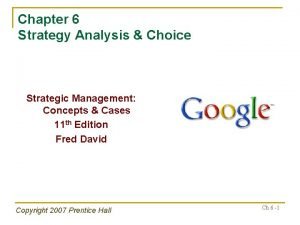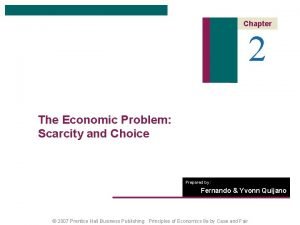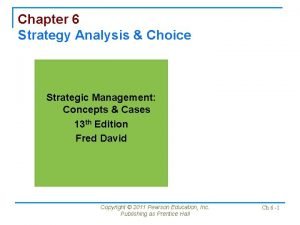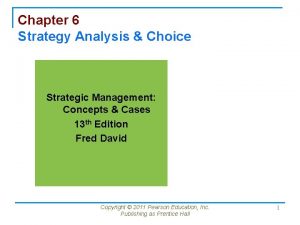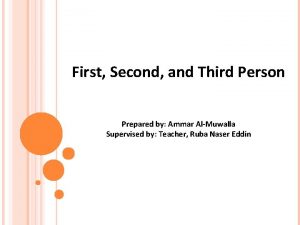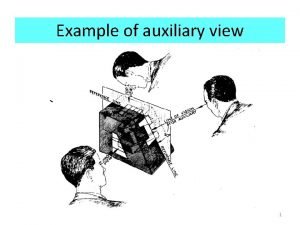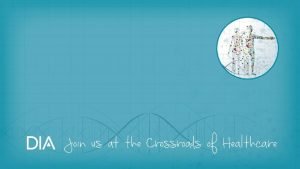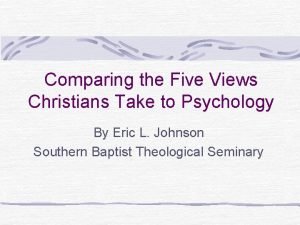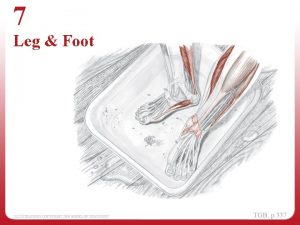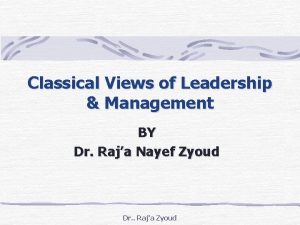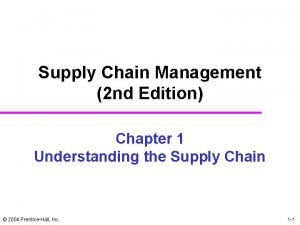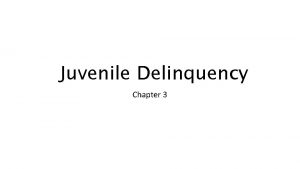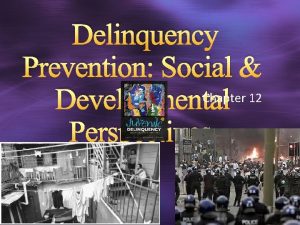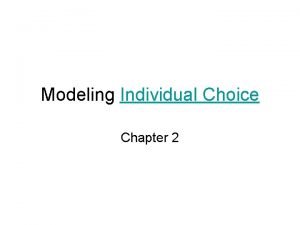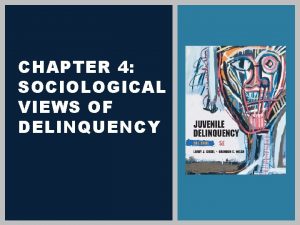CHAPTER 3 INDIVIDUAL VIEWS OF DELINQUENCY CHOICE AND










































- Slides: 42

CHAPTER 3: INDIVIDUAL VIEWS OF DELINQUENCY: CHOICE AND TRAIT

LEARNING OBJECTIVES After reading this chapter, students should be able to: 1. Know the principles of choice theory 2. Compare the principles of general deterrence, specific deterrence, and situational crime prevention 3. Trace the history and development of trait theory 4. Be familiar with the branches and substance of biological trait theory 5. Know the various psychological theories of delinquency

What Are Theories? § Theories are ideas criminologists use to explain facts Ø They represent the views of experts who live in a particular place at a particular time § Theories are evaluated on: Ø Simplicity Ø Testability Ø Empirical Validity

CHOICE THEORY § Emerged in the 18 th Century. § Philosophers formed the Core of Rational Choice Theory § Traced to the Classical School of Criminology. § Rational Choice Theory holds that the decision to violate the law comes after a careful weighing of the benefits Delinquents choose to commit crime because they find violating the law attractive…

CHOICE THEORY § Classical criminology § Cesare Beccaria & Jeremy Bentham § Choice Theory § Argues that people weigh and consider the consequences prior to the commission of their behaviors § Holds that the decision to violate the law comes after a careful weighing of the benefits § Assumes that people have “free will” to choose their behavior

QUESTION 1. ______ are ideas criminologists use to explain facts. a. Hypothesis b. Theories c. Empirical validity

THE RATIONAL DELINQUENT § The view that delinquents choose to violate the law remains a popular approach to the study of delinquents § In reality, many youths from affluent families choose to break the law § Delinquent motives include: § Economic need/opportunity § Problem solving § False expectations § Opportunity

ROUTINE ACTIVITIES THEORY § Developed by Lawrence Cohen and Marcus Felson § The view that crime is a normal function of the routine activities of modern living § Predatory crimes § Violent crimes against persons and crimes in which an offender attempts to steal an object from its holder are influenced by three variables: ① The availability of suitable targets ② The absence of capable guardians ③ The presence of motivated offenders

FIGURE 3. 1 ROUTINE ACTIVITIES THEORY HELPS EXPLAIN FLUCTUATIONS IN THE DELINQUENCY RATE

QUESTION 2. According to choice theorists, offenders: a. are rational actors who choose to crime because they believe their actions will be beneficial. b. are compelled to engage in crime because of specific physical or psychological conditions c. developed abnormal personality types d. have hormonal imbalances that have not been detected

QUESTION 3. Philosophers Beccaria and Bentham are identified as the core theorists of __________. a. b. c. d. criminal atavism classical criminology Marxism social learning

CHOICE THEORY AND DELINQUENCY PREVENTION § General Deterrence § Crime control policies that depend on the fear of criminal penalties, i. e. long prison sentences for violent crime § A guiding principle of deterrence is based on: § The severity of the punishment § The certainty of the punishment § The swiftness of the punishment § There is evidence that adolescents who perceive they will be arrested and punished for a crime will often forego delinquent acts

CHOICE THEORY AND DELINQUENCY PREVENTION § Specific Deterrence § If young offenders are punished severely they will not repeat their illegal acts § “Learn from their own mistakes” § For example, sending convicted offenders to secure incarceration facilities; punishment is severe enough to convince them not to repeat their criminal activity § However, in some cases experiencing punishment may actually increase the likelihood of reoffending

CHOICE THEORY AND DELINQUENCY PREVENTION § Problems with a strict deterrence strategy: § Minors are not “rational” § Experienced offenders do not fear the legal consequences § high-risk offenders may not fear getting arrested § Many juveniles are under influence of drugs/alcohol § Juveniles often commit crimes in groups – “cooffending” § Most serious delinquents are not able to comprehend consequences § Punishment may produce defiance, rather than deterrence

CHOICE THEORY AND DELINQUENCY PREVENTION § Situational Crime Prevention § In order to reduce delinquency, crime control must recognize the characteristics of sites and situations that are at risk to crime § Delinquency can be neutralized if: § Potential offenders are carefully guarded § The means to commit crime are controlled § Potential offenders are carefully monitored § Situational crime prevention includes : § Hot spot and crackdowns

QUESTION 4. A guiding principle of ________ is that the choice to commit delinquent acts can be controlled by the threat of punishment. a. general deterrence b. specific deterrence c. restorative justice d. retribution

QUESTION 5. According to the concept of _______, if offenders are punished severely, the experience will convince them not to repeat their illegal acts. a. specific deterrence b. general deterrence c. retribution d. restorative justice

TRAIT THEORIES: BIOSOCIAL AND PSYCHOLOGICAL VIEWS § Origins of Trait Theory § The school of thought is generally believed to have originated with the Italian physician Cesar Lombroso (1835 -1909) § Father of Criminology http: //youtu. be/n 29 YBw. BUTx. M § Criminal Atavism § Idea that delinquents manifest physical anomalies that make them biologically and psychologically similar to our primitive ancestors § By the middle of the 20 th century, biological theories had fallen out of favor

EUGENICS § Francis Galton § Describes the science of improving the human race through better breeding. § An inherited substance in the blood called germ plasma that is present at conception determines all of an individual’s mental, moral, and physical characteristics.

TRAIT THEORIES: BIOSOCIAL AND PSYCHOLOGICAL VIEWS § Contemporary Trait Theory § For most of the 20 th century, delinquency research focused on social factors § Trait theories argue that a combination of personal traits and environmental factors lead to behavior patterns § Today’s trait theories: § Biosocial theory § Delinquency can be found in a child’s physical or biological makeup § Psychological traits and characteristics

Mug Shot Study – Current Example Ø In 2006, after analyzing data from a federally sponsored survey of 15, 000 high school students, Naci Mocan of the University of Colorado and Erdal Tekin of Georgia State University concluded that unattractive individuals commit more crime in comparison to those who are average-looking ones, and very attractive individual commit less crime in comparison to those who are average-looking. ü Do you believe Lombroso was right about “Criminal atavism”? ü How would you explain the correlation found in Mocan and Tekin’s study?

BIOSOCIAL THEORIES OF DELINQUENCY § Focuses on the association between biological makeup, environmental conditions, and antisocial behaviors § Three areas of biosocial theories: ① Biochemical factors ② Neurological function ① Genetic history

BIOCHEMICAL FACTORS § Suspected relationship between antisocial behavior and biochemical makeup § Biochemical problems can begin at conception § i. e. , maternal alcohol abuse § Environmental contamination, such as children exposed to high levels of air pollution § There is evidence that a child’s diet may influences his or her behavior § Hormonal levels, such as increased levels of testosterone, are also associated with antisocial behavior

NEUROLOGICAL DYSFUNCTION § Neurological dysfunction, such as minimal brain dysfunction (MBD) is associated with antisocial behavior § Teenage brains: § Teenage brains can make them crime prone § ADHD: § Condition in which a child shows a developmentally inappropriate lack of attention and impulse § Learning Disabilities (LD): § Studies show that arrested children have a higher rate of LDs than children in the population § Arousal Theory: § “Thrill” and “sensation seekers” general

NEUROLOGICAL DYSFUNCTION

QUESTION 6. Research which links antisocial behavior to a person’s diet draws from which theoretical perspective? a. b. c. d. biosocial theories choice theory behaviorism personality trait theory

AUTONOMIC HYPO-ACTIVITY/ADHD § The most consistently documented biological correlate of delinquency is autonomic hypo-activity or an underaroused system marked by low resting heart rate § Low resting heart rate is more commonly found in boys than girls § David Farrington found low resting heart rate to be the most consistent predictor of crime

GENETIC INFLUENCES § It assumes: § Antisocial behavior is inherited § The genetic makeup of parent is passed on to children § Genetic abnormality is directly linked to antisocial behaviors § Three approaches to test the association: ① Parental deviance ② Twin studies ③ Adoption studies

Criminal Twins – Current Example Ø In the early morning hours of Sunday, Jan. 25, 2009, thieves managed to break into Berlin's famous, luxury department store Kaufhaus des Westens, stealing fine jewelry and pricey watches worth $6. 5 million. The thieves got away that night but left DNA behind. Identical twins Hassan and Abbas O. were arrested two weeks later, with police suspecting that at least one of them took part in theft. However, they were later released because their genetic information is so similar that traces of DNA found at the crime scene failed to provide conclusive evidence as to which one committed the crime. ü What do you think the chances are that these twins are both involved in the heist? Why?

PSYCHOLOGICAL THEORIES OF DELINQUENCY § Many delinquent youths have poor home lives, and destructive relationships with people around them; this can indicate a disturbed personality § One study of incarcerated youths found that at least 88% of males and 92% of females had a psychiatric disorder § Three prominent psychological perspectives: ① Psychodynamic theory ② Behavioral theory ③ Cognitive theory

FIGURE 3. 2 PSYCHOLOGICAL PERSPECTIVES OF DELINQUENCY

PSYCHODYNAMIC THEORY § Psychodynamic Theory § Branch of psychology that holds that the human personality is controlled by unconscious mental processes § Originated by Sigmund Freud (1856 -1939) § Personality consists of three major components: ① ② ③ Id Ego Superego § The theory suggests that an imbalance in personality traits, caused by early childhood, can result in long-term psychological difficulties

BEHAVIORAL THEORY/COGNITIVE THEORY § Behavioral Theory § Argument that personality is learned throughout life during interactions with others § “Behaviorism” concerns the study of observable behavior, rather than unconscious processes; focuses on particular stimuli and responses to them § Kids learn through reward and punishment § Cognitive Theory § Studies the perception of reality and the mental processes required to understand the world we live in

QUESTION 7. Which of the following is not one of the three prominent psychological perspectives: a. b. c. d. Psychodynamic theory Behavioral theory Cognitive theory Neurotic theory

PERSONALITY AND DELINQUENCY § Personality § The stable patterns of behavior, including thoughts and emotions, that distinguish one person from the other § Hans Eysenck’s two traits associate with antisocial behavior: ① Extraversion § Impulsive individuals who lack the ability to examine their own motives ② Neuroticism § Individuals who are anxious and emotionally unstable

QUESTION 8. Which of the following theories best reflects the branch of psychology that holds that the human personality is controlled by unconscious mental processes developed early in childhood? a. b. c. d. Psychodynamic theory Behavioral theory Cognitive theory General deterrence theory

PERSONALITY AND DELINQUENCY § Psychopathic personality § Also known as: Sociopathic or antisocial personality § A person lacking in warmth, exhibiting inappropriate behavior responses, and unable to learn from experience § Is defined by persistent violations of social norms

VA Tech Massacre – Current Example Ø During the early morning hours of April 16, 2007, Cho Seung-Hui, an English major at Virginia Tech, started a killing spree that left 32 people dead, including himself. Cho Seung-Hui was later described by his fellow students and professors as a loner and a person that was very disturbed and needed help. ü Can you identify some warning signs of a mentally disturbed individual? ü As students, how can you help to prevent a campus shooting like the Virginia Tech massacre?

INTELLIGENCE AND DELINQUENCY § Delinquents believed to be substandard in intelligence and thus inclined to commit more crimes § Nature Theory: § Intelligence is inherited and is a function of genetic makeup § Nurture Theory: § Intelligence is determined by environmental stimulation and socialization

TRAIT THEORY AND DELINQUENCY PREVENTION § Prevention efforts should be directed at strengthening a youth’s home life and relationships § Prenatal/Early Infancy Project (PEIP) § One of the best known home visitation programs § Individual approaches have been used to prevent adjudicated youths from engaging in further criminal activities § Rehabilitation methods include psychological counseling or prescribed psychotropic medications

QUESTION 9. People commit crimes when they model their behavior after others they see being rewarded for the same acts; behavior is reinforced by rewards and extinguished by punishment. Which of the following theories does this best illustrate? a. b. c. d. Psychodynamic Behavioral Cognitive General deterrence theory

SUMMARY… ü Ability to distinguish between the 2 branches of individual-level theories of delinquency ü Know the principles of choice theory ü Familiarity with the branches and substance of biological trait theory ü The various psychological theories of delinquency
 Developmental theory juvenile delinquency
Developmental theory juvenile delinquency According to choice theorists, offenders
According to choice theorists, offenders Nature and extent of juvenile delinquency
Nature and extent of juvenile delinquency Good choice or bad choice
Good choice or bad choice Individual choices
Individual choices Dun and bradstreet delinquency predictor score
Dun and bradstreet delinquency predictor score Poverty and juvenile delinquency
Poverty and juvenile delinquency Pnp delinquency report system
Pnp delinquency report system Delinquency management in microfinance
Delinquency management in microfinance Juvenile delinquency objectives
Juvenile delinquency objectives Juvenile justice vocabulary
Juvenile justice vocabulary Newspaper article on juvenile delinquency
Newspaper article on juvenile delinquency Female delinquency theories
Female delinquency theories What is a good delinquency predictor score
What is a good delinquency predictor score Categories of delinquent youth
Categories of delinquent youth Causes of juvenile delinquency
Causes of juvenile delinquency Delinquency management system
Delinquency management system Management of juvenile delinquency
Management of juvenile delinquency Juvenile offenders comprehension check answers
Juvenile offenders comprehension check answers Chapter 56 oral and maxillofacial surgery
Chapter 56 oral and maxillofacial surgery Chapter 37 vital signs and measurements
Chapter 37 vital signs and measurements Chapter 6 strategy analysis and choice
Chapter 6 strategy analysis and choice Strategic analysis and choice
Strategic analysis and choice Chapter 6 strategy analysis and choice
Chapter 6 strategy analysis and choice What are the two external dimensions of the space matrix?
What are the two external dimensions of the space matrix? Explain scarcity and choice
Explain scarcity and choice Input stage in strategic management
Input stage in strategic management Chapter 5 elasticity and its application multiple choice
Chapter 5 elasticity and its application multiple choice Strategy analysis and choice
Strategy analysis and choice One mirror two images views on singlehood and marriage
One mirror two images views on singlehood and marriage The views and opinions expressed
The views and opinions expressed We is second or third person
We is second or third person Auxiliary view drawing
Auxiliary view drawing How many standard or principal views are there?
How many standard or principal views are there? Orthographic projection
Orthographic projection Views and opinions disclaimer
Views and opinions disclaimer The views and opinions disclaimer
The views and opinions disclaimer Psychology and christianity: five views
Psychology and christianity: five views Googlemoa
Googlemoa Leg and foot topographical views
Leg and foot topographical views In the help strategy the h stands for healthful
In the help strategy the h stands for healthful Classical views of leadership and management
Classical views of leadership and management Push pull view of supply chain
Push pull view of supply chain
